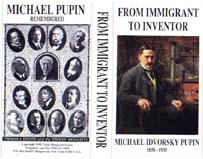 |
||
|
Links to other Tesla Organizations | Tesla and the exploration of Cosmos Price of Tape: $19.95 Call: (718) 417-5102 for information (USA) E-mail: teslasociety@aol.com for information.
Micheal
Pupin remembered (1854-1935) This is a film about
Michael ldvorsky Pupin, a Serbian-American inventor, a great educator,
professor of Columbia University, an applied physicist, an important
social figure in America at his time.
He was one of the great shining stars in the history of American The
film was produced after his famous book "From Immigrant to
Inventor" which received Pulitzer prize in 1924.
Columbia University collaborated in the production of this film.
This is the story of a little Serbian herder of cattle in the
village of ldvor, province of Banat near Belgrade, of how he ran away from
school at fifteen and came to America and worked his way on farms and in
factories, and finally won himself an education and became one of the
greatest scientists in an age of great scientists. Pupin
was best known for his contributions to applied physics, primarily
telephone and telegraph transmission, although he contributed to applied
medicine by his work in xray fluoroscopy and his method of decreasing the
duration of exposure to x-rays. Pupin
discovered the Pupin coil, which extended the range of long-distance
telephony; and a means of overcoming static resistance to wireless
telegraphy. When
the discovery of the x-rays was announced by Roentgen in December 1895,
Pupin was among the first to construct an x-ray tube, and he actually
obtained the first roentgenogram in America on January 2, 1896.
After the first trial, Pupin decided to try to find a way to reduce
the length of patients exposure to x-ray.
Using a fluorescent screen placed on top of the photographic plate,
he reduced the exposure time to a few seconds.
This original trial involved a surgical case in which the patient's
hand was filled with buckshot. This
was the first case in America to be aided by an x-ray picture.
The x-rays act on the fluorescent screen, which radiates the
x-rays, which in turn act on the photographic plate.
This was the discovery of the secondary x-ray radiation.
Pupin discovered Sonar, a method of detecting enemy U-Boats in the
Atlantic during WWI, which harassed allied ships on sea.
The Sonar discovery was a request from President Wilson. Pupin
received many awards and decorations for his service to science; these
included five medals and 18 honorary degrees.
In addition, he was elected to the National Academy of Sciences and
contributed much to funding of the American Mathematical Society and the
American Physical Society and to the formation of the National Research
Council. He was advisor to
the Yugoslavian delegation to the Paris Peace conference in 1919, which
contributed significantly to the formation of former Yugoslavia.
Pupin was an eloquent speaker with a poetic imagination and an
extraordinary personality. His
scientific addresses always carried the basic theme of idealism in
science, and he never failed to stress idealism in life. Pupin
died of kidney failure on March 12,1935, in New York City.
He was honored This
film "From Immigrant to Inventor" is a tribute to.
Michael ldvorsky Pupin for
|
||
